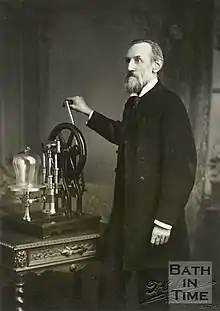
John Arthur Roebuck Rudge (26 July 1837 – 3 January 1903)[1] was a British scientific instrument maker and inventor, who lived in Bath, noted for his contributions to the development of moving pictures. He collaborated with William Friese-Greene and, around 1880, he invented a device known as the Biophantic Lantern.[2] This rotated seven square slides around a circular lamp housing, using a movement similar to the Maltese Cross, later found in many film projectors. The light was obscured between images via a pair of ground glass shutters. The only surviving sequence – likely the only one ever made – shows Rudge taking off his own head and putting it under his arm. The trick was carried out by Friese-Greene playing the body.[3] This lantern and the slides are now to be found in the Cinémathèque Française.
Over the following decade Rudge came up with a series of magic lantern experiments to try to recreate movement, calling all of these 'Biophantoscopes'. All employed individually posed photographs, rather than images taken with a moving picture camera, and featured changing faces.[4]
See also
References
- ↑ "The Rudge Centenary". Bath Chronicle and Weekly Gazette. British Newspaper Archive. 9 January 1937. p. 10. (subscription required)
- ↑ "John Rudge". sciencemuseumgroup.org.uk. Science Museum Group. Retrieved 8 April 2022.
- ↑ William Friese-Greene & The Art of Collaboration, retrieved 2021-06-24
- ↑ Who's Who of Victorian Cinema